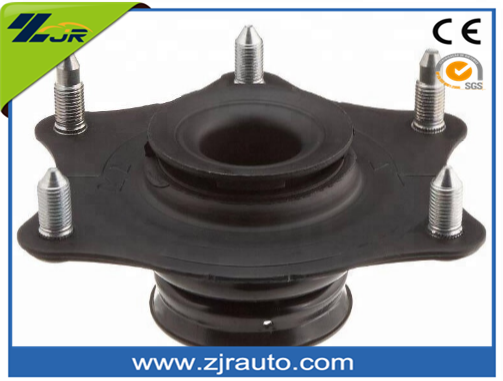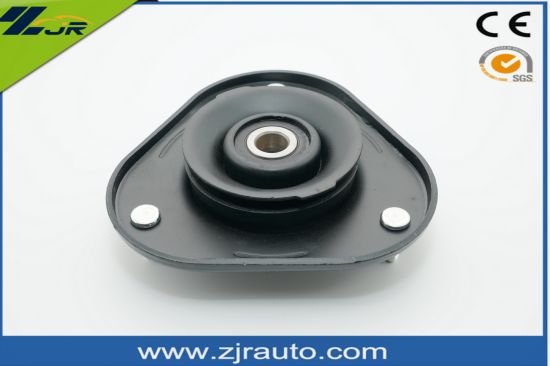- All
- Product Name
- Product Keyword
- Product Model
- Product Summary
- Product Description
- Multi Field Search
Views: 2 Author: Site Editor Publish Time: 2024-06-04 Origin: Site








Strut mounts play a pivotal role in a vehicle's suspension system, acting as the interface between the vehicle's body and the strut assembly. They help absorb shocks from the road, reduce noise, and ensure a smoother ride. Over time, strut mounts can wear out or become misaligned, leading to the need for rotation or replacement. This article will guide you through the process of rotating a strut mount, ensuring that your vehicle continues to perform optimally.
Before diving into the rotation process, it's essential to understand what a strut mount is and its role in the suspension system. A strut mount is a component that connects the strut to the vehicle's chassis. It is usually made of metal and rubber and often includes a bearing to allow the strut to rotate when turning the steering wheel. Strut mounts serve several functions:
Absorbing Shock: They help absorb road shocks, contributing to ride comfort.
Noise Reduction: They reduce noise and vibrations from the road.
Alignment: They assist in maintaining proper alignment of the strut and wheel.
There are different types of strut mounts, including the traditional strut mount, torque strut mount, and bearing strut mount. Each has specific features and functions within the suspension system.

Rotating a strut mount might be necessary for several reasons:
Uneven Wear: If the strut mount shows signs of uneven wear, rotating it can help prolong its life.
Improved Handling: Properly aligned strut mounts ensure better handling and steering response.
Preventative Maintenance: Regular inspection and rotation can prevent more severe issues down the road, such as misalignment or uneven tire wear.
In the intricate web of a vehicle's suspension system, the partnership between the strut and its mount emerges as a critical nexus. Struts, those resilient pillars of support, absorb the undulating force of the road, while their mounts, akin to silent sentinels, anchor them securely to the chassis. Together, they orchestrate a symphony of motion and stability, ensuring a smooth and controlled ride. Understanding the symbiotic relationship between strut and strut mount unveils the foundation upon which automotive performance rests, guiding us towards a deeper appreciation of their indispensable role in vehicular dynamics.

Before starting the rotation process, gather the necessary tools and materials:
Jack and jack stands
Lug wrench
Socket set
Torque wrench
Strut compressor (if needed)
Replacement strut mount (if necessary)
Penetrating oil
Safety glasses and gloves
Park on a Level Surface: Ensure your vehicle is parked on a flat, level surface. Engage the parking brake.
Safety First: Wear safety glasses and gloves to protect yourself from debris and sharp components.
Loosen Lug Nuts: Using a lug wrench, slightly loosen the lug nuts on the wheel where the strut mount needs attention. Do not remove them completely.
Jack Up the Vehicle: Position the jack under the vehicle's jacking point (consult your owner's manual for the exact location). Lift the vehicle until the wheel is off the ground.
Secure with Jack Stands: Place jack stands under the vehicle for added safety. Never rely solely on the jack.
Remove Lug Nuts: Fully remove the lug nuts and take off the wheel, setting it aside.
Locate the Strut Assembly: Identify the strut assembly. The strut mount is typically located at the top of the strut, inside the engine bay or wheel well.
Apply Penetrating Oil: Spray penetrating oil on the bolts and nuts that secure the strut mount to help loosen them.
Disconnect the Strut: Depending on your vehicle, you may need to disconnect the brake line or ABS sensor attached to the strut.
Remove Bolts: Use a socket set to remove the bolts securing the strut to the vehicle's chassis. There may be bolts at both the top and bottom of the strut assembly.
Compress the Spring: If your strut mount is part of a coilover assembly, use a strut compressor to compress the spring. This step is critical to avoid injury, as the spring is under high tension.
Remove the Old Strut Mount: Once the strut is free, remove the old strut mount. Pay attention to the orientation of the mount before removal.
Rotate or Replace the Strut Mount: Rotate the strut mount to the desired position or replace it with a new one. Ensure the new or rotated mount aligns correctly with the strut and vehicle chassis.
Reinstall the Strut Mount: Attach the strut mount back onto the strut assembly, ensuring all components are aligned correctly.
Reattach the Strut: Reattach the strut assembly to the vehicle, securing it with the bolts you previously removed. Use a torque wrench to tighten the bolts to the manufacturer's specifications.
Put the Wheel Back On: Place the wheel back onto the hub and hand-tighten the lug nuts.
Lower the Vehicle: Carefully lower the vehicle using the jack and remove the jack stands.
Tighten Lug Nuts: Use a torque wrench to tighten the lug nuts in a star pattern to the manufacturer's recommended torque specification.
Check Alignment: After rotating or replacing the strut mount, it's a good idea to have the vehicle's alignment checked by a professional. Proper alignment ensures even tire wear and optimal handling.
Test Drive: Take your vehicle for a test drive to ensure everything is functioning correctly. Listen for any unusual noises and pay attention to the handling.
Regular Inspection: Periodically inspect strut mounts for signs of wear, such as cracks, rust, or uneven wear.
Smooth Ride: If you notice a rough ride, unusual noises, or changes in steering response, check the strut mounts.
Professional Help: For complex issues or if you're unsure about any steps, seek professional assistance to avoid further damage or safety risks.

Rotating a strut mount is a task that can help extend the life of your vehicle's suspension system and ensure a smoother ride. By following this detailed guide, you can tackle the job with confidence. However, always prioritize safety and, if in doubt, seek professional assistance.
For high-quality strut mounts and other automotive parts, we recommend checking out zjrauto. They offer a wide range of reliable and durable products to keep your vehicle running smoothly. For inquiries, you can reach them at info@zjrauto.com
By taking care of your strut mounts, you contribute to the overall health and performance of your vehicle, ensuring safer and more comfortable drives ahead.